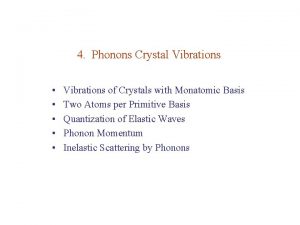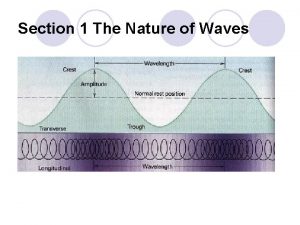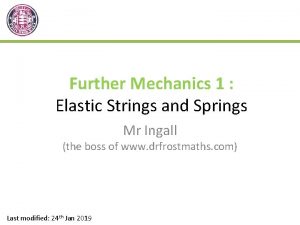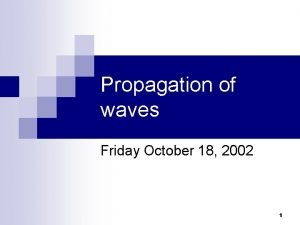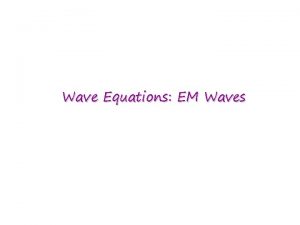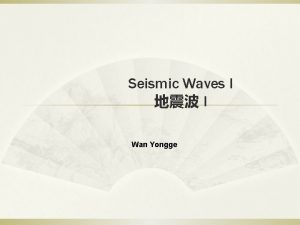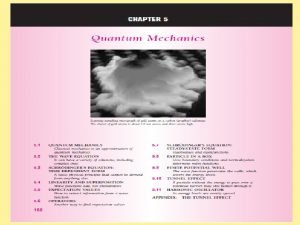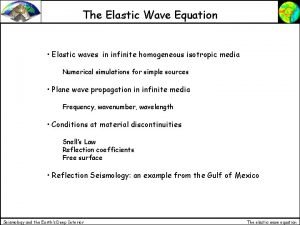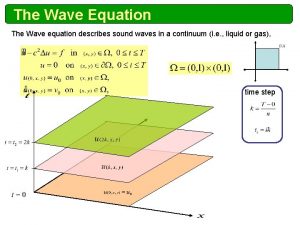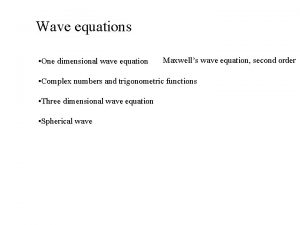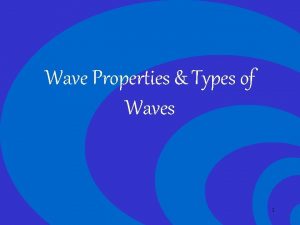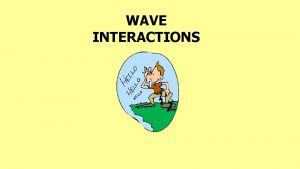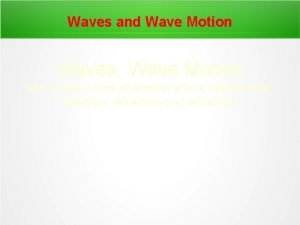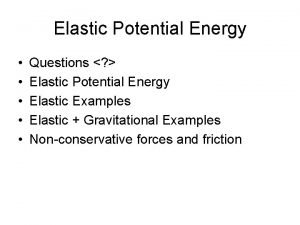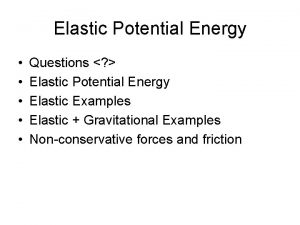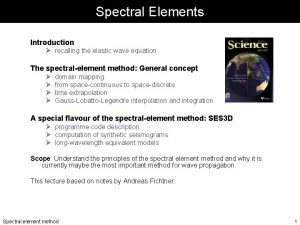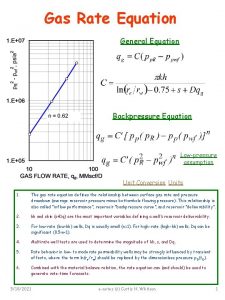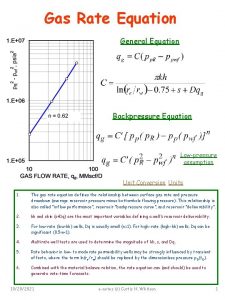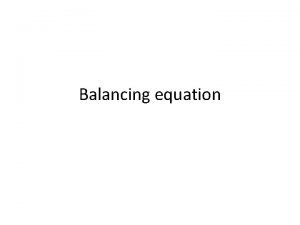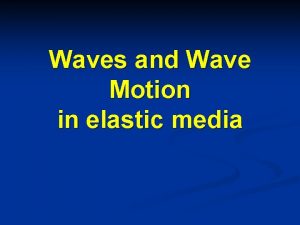The Elastic Wave Equation Elastic waves in infinite

































- Slides: 33

The Elastic Wave Equation Ø Elastic waves in infinite homogeneous isotropic media ØNumerical simulations for simple sources Ø Plane wave propagation in infinite media ØFrequency, wavenumber, wavelength Ø Conditions at material discontinuities ØSnell’s Law ØReflection coefficients ØFree surface Ø Reflection Seismology: an example from the Gulf of Mexico Seismology and the Earth’s Deep Interior The elastic wave equation

Equations of motion What are the solutions to this equation? At first we look at infinite homogeneous isotropic media, then: Seismology and the Earth’s Deep Interior The elastic wave equation

Equations of motion – homogeneous media We can now simplify this equation using the curl and div operators and … this holds in any coordinate system … This equation can be further simplified, separating the wavefield into curl free and div free parts Seismology and the Earth’s Deep Interior The elastic wave equation

Equations of motion – P waves Let us apply the div operator to this equation, we obtain Acoustic wave equation where P wave velocity or Seismology and the Earth’s Deep Interior The elastic wave equation

Equations of motion – shear waves Let us apply the curl operator to this equation, we obtain we now make use of Wave equation for shear waves Seismology and the Earth’s Deep Interior and define to obtain Shear wave velocity The elastic wave equation

Elastodynamic Potentials Any vector may be separated into scalar and vector potentials where F is the potential for P waves and Y the potential for shear waves P-waves have no rotation Seismology and the Earth’s Deep Interior Shear waves have no change in volume The elastic wave equation

Seismic Velocities Material and Source P-wave velocity (m/s) shear wave velocity (m/s) Water 1500 0 Loose sand 1800 500 Clay 1100 -2500 Sandstone 1400 -4300 Anhydrite, Gulf Coast 4100 Conglomerate 2400 Limestone 6030 3030 Granite 5640 2870 Granodiorite 4780 3100 Diorite 5780 3060 Basalt 6400 3200 Dunite 8000 4370 Gabbro 6450 3420 Seismology and the Earth’s Deep Interior The elastic wave equation

Solutions to the wave equation - general Let us consider a region without sources Where n could be either dilatation or the vector potential and c is either Por shear-wave velocity. The general solution to this equation is: Let us take a look at a 1 -D example Seismology and the Earth’s Deep Interior The elastic wave equation

Solutions to the wave equation - harmonic Let us consider a region without sources The most appropriate choice for G is of course the use of harmonic functions: Seismology and the Earth’s Deep Interior The elastic wave equation

Solutions to the wave equation - harmonic … taking only the real part and considering only 1 D we obtain Seismology and the Earth’s Deep Interior c wave speed k wavenumber l wavelength T period w frequency A amplitude The elastic wave equation

Spherical Waves Let us assume that h is a function of the distance from the source r where we used the definition of the Laplace operator in spherical coordinates let us define to obtain with the known solution Seismology and the Earth’s Deep Interior The elastic wave equation

Geometrical spreading so a disturbance propagating away with spherical wavefronts decays like r. . . this is the geometrical spreading for spherical waves, the amplitude decays proportional to 1/r. If we had looked at cylindrical waves the result would have been that the waves decay as (e. g. surface waves) Seismology and the Earth’s Deep Interior The elastic wave equation

Plane waves. . . what can we say about the direction of displacement, the polarization of seismic waves? . . . we now assume that the potentials have the well known form of plane harmonic waves P waves are longitudinal as P is parallel to k Seismology and the Earth’s Deep Interior shear waves are transverse because S is normal to the wave vector k The elastic wave equation

Heterogeneities. . What happens if we have heterogeneities ? Depending on the kind of reflection part or all of the signal is reflected or transmitted. Ø Ø Ø Seismology and the Earth’s Deep Interior What happens at a free surface? Can a P wave be converted in an S wave or vice versa? How big are the amplitudes of the reflected waves? The elastic wave equation

Wavenumber, slowness, phase velocity Seismology and the Earth’s Deep Interior The elastic wave equation

Reflection at an interface Seismology and the Earth’s Deep Interior The elastic wave equation

Boundary Conditions . . . what happens when the material parameters change? r 1 v 1 welded interface r 2 v 2 At a material interface we require continuity of displacement and traction A special case is the free surface condition, where the surface tractions are zero. Seismology and the Earth’s Deep Interior The elastic wave equation

Reflection and Transmission – Snell’s Law What happens at a (flat) material discontinuity? Medium 1: v 1 i 2 Medium 2: v 2 But how much is reflected, how much transmitted? Seismology and the Earth’s Deep Interior The elastic wave equation

Reflection and Transmission coefficients Let’s take the most simple example: P-waves with normal incidence on a material interface R A Medium 1: r 1, v 1 Medium 2: r 2, v 2 T At oblique angles conversions from S-P, P-S have to be considered. Seismology and the Earth’s Deep Interior The elastic wave equation

Reflection and Transmission – Ansatz How can we calculate the amount of energy that is transmitted or reflected at a material discontinuity? We know that in homogeneous media the displacement can be described by the corresponding potentials in 2 -D this yields an incoming P wave has the form Seismology and the Earth’s Deep Interior The elastic wave equation

Reflection and Transmission – Ansatz. . . here ai are the components of the vector normal to the wavefront : ai=(cos e, 0, -sin e), where e is the angle between surface and ray direction, so that for the free surface e where f Pr P SVr what we know is that Seismology and the Earth’s Deep Interior The elastic wave equation

Reflection and Transmission – Coefficients. . . putting the equations for the potentials (displacements) into these equations leads to a relation between incident and reflected (transmitted) amplitudes These are the reflection coefficients for a plane P wave incident on a free surface, and reflected P and SV waves. Seismology and the Earth’s Deep Interior The elastic wave equation

Case 1: Reflections at a free surface A P wave is incident at the free surface. . . i P j SV P The reflected amplitudes can be described by the scattering matrix S Seismology and the Earth’s Deep Interior The elastic wave equation

Example Seismology and the Earth’s Deep Interior The elastic wave equation

Case 2: SH waves For layered media SH waves are completely decoupled from P and SV waves SH There is no conversion only SH waves are reflected or transmitted Seismology and the Earth’s Deep Interior The elastic wave equation

Example Seismology and the Earth’s Deep Interior The elastic wave equation

Case 3: Solid-solid interface P SVr P r SVt Pt To account for all possible reflections and transmissions we need 16 coefficients, described by a 4 x 4 scattering matrix. Seismology and the Earth’s Deep Interior The elastic wave equation

Case 4: Solid-Fluid interface P SVr P r Pt At a solid-fluid interface there is no conversion to SV in the lower medium. Seismology and the Earth’s Deep Interior The elastic wave equation

Reflection coefficients - example Seismology and the Earth’s Deep Interior The elastic wave equation

Refractions – waveform effects Seismology and the Earth’s Deep Interior The elastic wave equation

Reservoir example Seismology and the Earth’s Deep Interior The elastic wave equation

Example: Gulf of Mexico Seismology and the Earth’s Deep Interior The elastic wave equation

Summary Ø Reflection and transmission coefficients can be derived using plane waves and boundary conditions Ø Cases include: Ø Ø Ø solid-solid-fluid-solid-free surface fluid-free surface Ø The angular dependence of R-T coefficients is complex. Their behaviour allows constraining the change of physical properties. Seismology and the Earth’s Deep Interior The elastic wave equation
 Infinite diversity in infinite combinations
Infinite diversity in infinite combinations Microscopic structure of hyaline cartilage
Microscopic structure of hyaline cartilage Two atoms per primitive basis
Two atoms per primitive basis Mechanical waves and electromagnetic waves similarities
Mechanical waves and electromagnetic waves similarities Longitudinal vs transverse wave
Longitudinal vs transverse wave Example of a mechanical wave
Example of a mechanical wave Similarities of mechanical waves and electromagnetic waves
Similarities of mechanical waves and electromagnetic waves What type of waves are sound waves? *
What type of waves are sound waves? * Sound is a longitudinal wave
Sound is a longitudinal wave Long waves and short waves
Long waves and short waves Difference between matter waves and electromagnetic waves
Difference between matter waves and electromagnetic waves Mechanical waves vs electromagnetic waves
Mechanical waves vs electromagnetic waves Mechanical waves and electromagnetic waves similarities
Mechanical waves and electromagnetic waves similarities Surface waves and body waves
Surface waves and body waves Seismic waves are mechanical waves
Seismic waves are mechanical waves Compare and contrast p waves and s waves using venn diagram
Compare and contrast p waves and s waves using venn diagram Mechanical wave and electromagnetic wave
Mechanical wave and electromagnetic wave Constructive waves and destructive waves difference
Constructive waves and destructive waves difference Ability of two or more waves to combine and form a new wave
Ability of two or more waves to combine and form a new wave Difference between full wave and half wave rectifier
Difference between full wave and half wave rectifier Transverse and longitudinal waves both *
Transverse and longitudinal waves both * Half wave rectifier definition
Half wave rectifier definition Fullwave rectification
Fullwave rectification Earthquake p-wave and s-wave travel time graph
Earthquake p-wave and s-wave travel time graph Full wave rectified sine wave fourier series
Full wave rectified sine wave fourier series What is a repeating disturbance
What is a repeating disturbance The wave chapter 10
The wave chapter 10 When does a wave posses a quarter wave symmetry
When does a wave posses a quarter wave symmetry Wavelength formula triangle
Wavelength formula triangle Tension in elastic string
Tension in elastic string Spherical waves equation
Spherical waves equation Wave equations
Wave equations P wave formula
P wave formula Expectation value of position
Expectation value of position


